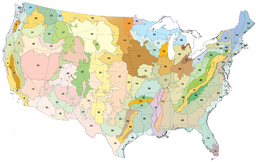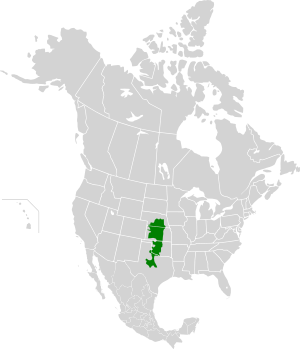Central Great Plains (ecoregion) facts for kids
Quick facts for kids Central Great Plains |
|
|---|---|

Tornado north of Solomon, Kansas
|
|

Central Great Plains (area 27 on the map)
|
|
| Ecology | |
| Realm | Nearctic |
| Biome | Temperate grasslands, savannas, and shrublands |
| Borders |
List
|
| Bird species | 228 |
| Mammal species | 88 |
| Geography | |
| Country | United States |
| State | Texas, Oklahoma, Kansas, Nebraska |
| Climate type | Humid continental (Dfa) and humid subtropical (Cfa) |
| Conservation | |
| Habitat loss | 50.68% |
| Protected | 0.48% |
The Central Great Plains is a special natural area in the central United States. It's a type of prairie, which means it's mostly covered in grasses. This amazing region is part of the larger Great Plains of North America. You can find it stretching from west-central Texas, through west-central Oklahoma, central Kansas, and into south-central Nebraska. The World Wide Fund for Nature calls this area the Central and Southern Mixed Grasslands, highlighting its unique mix of plant life.
Contents
Where in the World Are the Central Great Plains?
Imagine a huge area of grassland with hardly any trees! That's the Central Great Plains. It stretches from central Nebraska in the north, down through central Kansas and western Oklahoma, all the way to north-central Texas. This vast region covers about 282,000 square kilometers (that's about 108,881 square miles!).
This area is like a natural bridge, or a transition zone, between different types of grasslands. To the east, you'll find taller grasses and areas where forests start to mix with grasslands. To the west, the grasses are shorter. Up north, the Northern mixed grasslands have cooler weather and a shorter time for plants to grow. To the south, you'll find the Edwards Plateau Savannas.
Amazing Plants of the Plains
The Central Great Plains is famous for its beautiful and diverse plant life, especially its grasses! Here, you'll find a rich mix of prairie grasses that are medium height. It's a special place because it has both tall grasses and short grasses growing together. This mix creates a unique habitat.
Among the grasses, you'll see many colorful wildflowers. However, there are very few trees or bushes. The plants here are tough! They can handle challenges like dry weather (droughts) and natural fires. Some other plants that thrive here are the honey mesquite and different kinds of prickly pear cacti, which are excellent at surviving with little water.
Wildlife Wonders: Animals of the Plains
This prairie was once the natural home for huge herds of American bison, also known as buffalo! These magnificent animals are native to the Great Plains. Since the 1800s, much of this land has been used for grazing cattle.
The grasslands are also a perfect home for many birds that live here all year round. But that's not all! The wet areas, called wetlands, are super important resting spots for birds traveling long distances. These birds migrate between North America and Mexico.
Birds on the Move: Migratory Marvels
Places like the Cheyenne Bottoms in Kansas and the Platte River in Nebraska are vital for migrating birds. You can see thousands of sandhill cranes and other waders (birds that walk in shallow water) stopping here on their incredible journeys.
Reptiles and Other Creatures
The Central Great Plains is also home to many different reptiles. In the southern parts of the region, you might spot clever coyotes. There are also interesting creatures like the striped bark scorpion and the prairie rattlesnake (Crotalus viridis). Don't worry, these animals are usually shy and prefer to be left alone! Another cool reptile is the Great Plains skink (Plestiodon obsoletus), a type of lizard.
Protecting Our Prairies: Conservation Efforts
Sadly, a big part of these amazing grasslands has been changed into farms. Only about 5% of the original natural habitat is left today. In the 1930s, this area faced a huge challenge called the Dust Bowl. Because too much land was plowed up, the rich topsoil dried out and was blown away by strong winds, creating massive dust storms.
Since then, the grasslands have recovered. However, much of the land is now used for growing crops or for controlled grazing by farm animals, instead of being completely wild and untouched. It's super important to protect the remaining natural areas!
Special Places: Protected Areas
Even though much of the land has changed, there are still some special places where the natural habitat is protected. These include:
- In Oklahoma: The Wichita Mountains and the Great Salt Plains Lake within the Salt Plains National Wildlife Refuge.
- In Nebraska: The Platte River State Park near Louisville, Nebraska, and the Rainwater Basins.
- In Kansas: The Cheyenne Bottoms, the Quivira National Wildlife Refuge near Stafford, the Red Hills, and the Smoky Hills areas.
These protected areas are like islands of natural grassland surrounded by farms. The two biggest and most important protected areas are the Wichita Mountains Wildlife Refuge, which helps protect bison and the black-capped vireo bird, and the Salt Plains National Wildlife Refuge. These places are vital for keeping the unique plants and animals of the Central Great Plains safe.
Explore More About the Plains
- The Great Plains Ecoregion
- Flora of the Great Plains (North America) (Plants of the Great Plains)
- Great Plains (More about the Great Plains)
- Temperate grasslands, savannas, and shrublands in the United States (Other similar natural areas in the U.S.)
- List of ecoregions in the United States (EPA)
- List of ecoregions in the United States (WWF)


